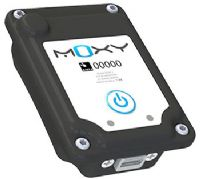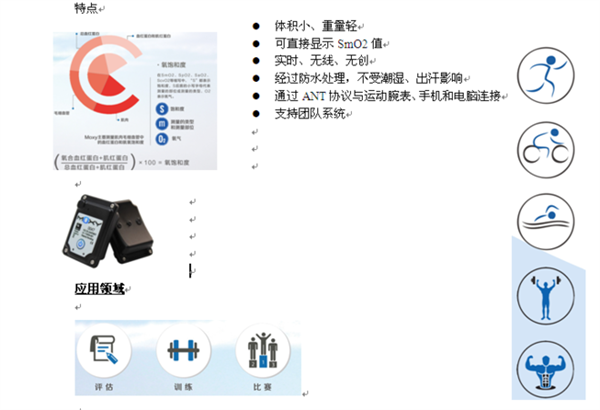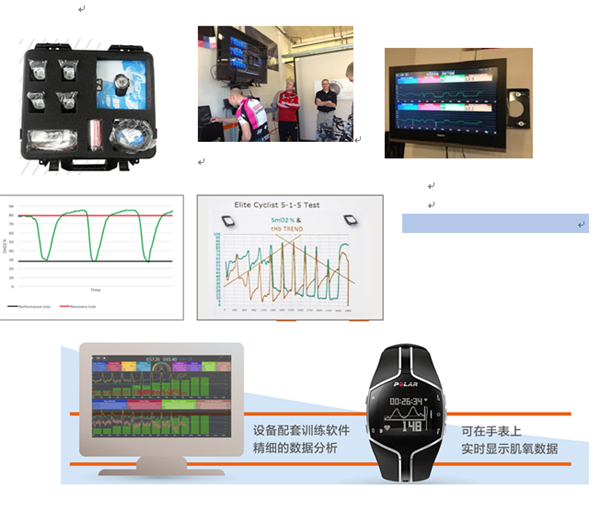Through the Moxy Muscle Oxygen Monitor, SmO2 (muscle oxygen saturation) in muscle capillaries can be displayed in real time, assisting in observing the analysis of athletes' muscle oxygen content and exercise capacity during exercise. The Moxy Muscle Oxygen Monitor works by illuminating the skin with near-infrared light and then detecting some of the light that returns to the surface of the skin after entering the muscle tissue. The visible light spectrum ranges from about 380 nm at the purple end to 750 nm at the red end. The Moxy monitor utilizes four independent light sources with wavelengths ranging from 630 to 850 nm. Muscle aerobic power helps us understand the muscle metabolism and, therefore, can be used to guide different exercises. The purpose of MOXY for endurance training is to help users achieve and maintain training intensity. This paper is related to the impact of basketball players' short-term sprint interval training on muscle oxygen content and exercise capacity. Original title: The effect of short-term sprint interval training on muscle oxygen content and exercise capacity of young male basketball players.

Moxy near-infrared light real-time wireless non-invasive muscle oxygen monitor
Observing the effects of short-term sprint interval training on muscle oxygen content and exercise capacity of athletes during exercise, and providing a basis for scientifically and rationally formulating training plans. Thirty young male basketball players were randomly divided into experimental group (EG, n=15) and control group (CG, n=15). CG athletes are trained normally. EG performs two sprint interval trainings per week on the basis of normal training. The experimental period is 4 weeks. The aerobic exercise capacity was measured by the incremental load test before and after the experiment; the anaerobic exercise capacity was measured by the 30s Wingate test; the near-infrared spectroscopy (NIRS) was used to monitor the high-intensity intermittent exercise test (repeated 5 times 30sWingate test, intermittent 4min) Changes in muscle oxygen content. The results showed that after the experiment, the maximum oxygen uptake and maximum aerobic power of the EG subjects in the incremental load experiment were compared with those before the experiment (P<0.05), and the peak power and average power of the Wingate experiment. Increased (P<0.05), the absolute values ​​of oxyhemoglobin and oxygenated myoglobin, deoxyhemoglobin and deoxymyoglobin and tissue oxygenation index were significantly increased in intermittent exercise experiments (P<0.05), hemoglobin There was no significant change in the total amount (P>0.05); there was no significant change in all indicators of CG subjects (P>0.05). The results showed that the short-term sprint interval training improved the aerobic and anaerobic exercise capacity of young male basketball players and the oxygen-absorbing ability of peripheral skeletal muscles during intermittent exercise.
Basketball programs often require athletes to make intermittent movements such as acceleration, full-strength sprint, etc., and their intensity often exceeds the maximum oxygen uptake (super-strength) and lasts for a few seconds. According to statistics, the super-strong movement of basketball players in a game can account for 11.2% to 18.8% of the total moving distance [1]. Therefore, from the perspective of total energy supply, basketball belongs to aerobic exercise, but short-term anaerobic supply Can account for nearly a quarter of the proportion, and anaerobic capacity is the key factor in determining the outcome of the game. Sprint interval training (SIT) is a model of high-intensity interval training that simultaneously develops athletes' aerobic and anaerobic exercise abilities, characterized by intensity movements that approach or exceed maximum aerobic capacity and alternate intermittent intervals [ 2]. At SIT, athletes need to sprint (run, ride, swim, etc.) to maintain high or even the highest physiological stimuli and reactions [2]. The mechanism by which SIT improves exercise capacity is related to skeletal muscle system, cardiovascular system, respiratory system structure and function improvement, and metabolic adaptation [3-4].

Moxy's high-precision sensors and ultra-lightweight design allow trainers and athletes to feedback and monitor the intensity of the target muscles in real time. Whether it's aerobic training, strength training, interval training or post-injury repair, Moxy can make coaches Players or athletes obtain high-precision quantitative data.
Studies have confirmed that SIT can improve skeletal muscle oxidative capacity, but the specific mechanism is still unclear. Near-infrared spectroscopy (NIRS) can acquire changes in oxygen metabolism in skeletal muscle through the oxygen-dependent characteristics of near-infrared light [5]. NIRS has been widely used in clinical medicine, but few studies have been conducted in sports medicine and exercise training [6]. The advent of portable myocardometers facilitates the observation of changes in muscle oxygen metabolism during exercise. Whether it is a laboratory test or a sports field test, NIRS has a high degree of reliability, providing information on muscle oxygenation levels, deoxygenation rates, and reoxygenation rates during exercise [6]. Even short-term exercise (such as sprint training for a few seconds), you can quickly get muscle oxygen metabolism in exercise through NIRS. Because NIRS can perform non-invasive detection and wireless telemetry with high reliability, it can be used for athletes to provide protection for individualized training programs and training adjustment. The acute response to physical function to SIT has been well established [7-8], but SIT-induced chronic physiological adaptation has received little attention. The aim of this study was to investigate the effects of short-term SIT on muscle oxygen content and exercise capacity in young male basketball players.
1 research objects and methods
1.1 Research object
30 young men (aged 18 to 22 years old) basketball players were selected, with national level 1 and level 2. The subjects are healthy, have no cardiovascular and pulmonary diseases, metabolic diseases and motor system diseases, smoke-free wine hobbies, no acute or chronic infections, sports injuries and the use of drugs and nutritional supplements. Subjects were randomly divided into experimental group (EG) and control group (CG), with 15 patients in each group. CG athletes are trained for 4 weeks, and EG still needs to complete SIT intervention twice a week for 4 weeks on the basis of normal training.
1.2 overall design of the experiment
Inform the precautions and sign an informed consent form before the experiment. The subjects entered the exercise physiology laboratory three times for related tests. The first time: familiar with the experimental process and the use of power bicycles and pre-experiment. The second time: after 48h interval, the body morphology and hemodynamic parameters were measured, the aerobic exercise capacity was measured by the incremental load test, the anaerobic exercise capacity was measured by one Wingate test, and the high-intensity intermittent exercise was measured by the portable muscle oxygen meter. Changes in muscle oxygen content during the experiment. The next four weeks of experimental intervention began. The third time: After the last experiment for 48 hours, the above tests were performed again, and the content was the same as the second time.嘱 Subjects should have a light diet 48 hours before the experiment to avoid strenuous exercise and avoid smoking, drinking and drinking coffee.
1.3 Body morphology, hemodynamics determination
Body height (m), body mass (kg) were measured and body mass index (BMI) was calculated. Body composition, including fat mass (FM), freefat mass (FFM), and percentage of body fat (percentbodyfat, BF (%)), were measured by a bioelectrical impedance method using a body composition analyzer (Inbody 520, Korea). After sitting for 5 to 10 minutes, the right upper arm radial artery blood pressure was measured with a standard bench-top mercury column sphygmomanometer. The mean value was measured 3 times (5 minutes each time), and systolic blood pressure (SBP) and diastolic blood pressure (DBP) were obtained. The pulse was averaged 3 times (4 x 15 s) as the heart rate (HR) value.
1.4 Determination of aerobic capacity
Aerobic exercise capacity was determined experimentally using an incremental load power vehicle (Monark 839E, Sweden). Test plan: starting load 90W, incrementing 30W every 2min, maintaining 60r/min braking speed. Ventilation indicators such as oxygen uptake (VO2) and CO2 exhalation (VCO2) were measured using the German Cortex II exercise cardiopulmonary metabolic system, and HR was recorded using a telemetry heart rate monitor (PolarS800, Finland) based on the rating of peripheral dysfunction (RPE) scale. (Levels 6-20) Record the degree of fatigue. The experiment is terminated if there are 3 of the following 4 criteria: (1) respiratory quotient (RQ=VCO2/VO2) exceeds 1.15; (2) heart rate exceeds 180b/min; (3) oxygen uptake platform, ie VO2 The magnitude of the change did not exceed 150 mL/min; (4) the subject complained of exhaustion. At this time, the VO2 value is the maximum oxygen uptake (maximaloxygenuptake, VO2max), and the maximum heart rate (HRmax), the maximum blood pressure value (SBPmax and DBPmax), the maximum aerobic power (MAP), the maximum RQ (RQmax), and the maximum RPE are recorded. (RPEmax).
1.5 Determination of muscle oxygen content
A high-intensity intermittent exercise experiment was performed using an anaerobic power bicycle (Powermax VII, Japan) (repeated 5 times 30s Wingate test, intermittent period 4 min). The subjects were first prepared for 5-10 minutes, and then the formal experiment was started. The subjects tried their best to brake the car, and the resistance increased. The specified load was reached within 2 to 3 seconds (resistance load was 0.075 kg/kg). Subjects were given verbal encouragement and ended in 30s. Intermittent subjects sit quietly on the power car for 4 minutes. Changes in muscle oxygen content were continuously monitored using a portable myocardometer (ISAH-100, China). Select the lateral side of the quadriceps muscle, which is the largest in the human body and the main motility muscle in this movement, as the monitoring point of the muscle oxygen content. Place the probe longitudinally 10 to 12 cm on the midpoint of the right thigh humerus. The axis is parallel to the thigh. To prevent the effects of sweat, attach an ultra-thin transparent plastic film between the probe and the skin and fix the probe with a special light-shielding device to prevent light leakage. Connect the myocardium to the computer with Bluetooth, collect data every 0.1s and get the following indicators: deoxyhaemoglobin and deoxymyoglobin (HHb+HMb), oxyhemoglobin and oxygenated myoglobin (oxyhaemoglobin+) Oxymyoglobin, HbO2+MbO2), tissue oxygenation index (TSI) and total hemoglobin (tHb). The difference between the data in the experiment and the quiet base value (the average value of 30 s in the quiet state before the test) was taken as the change amount of the index, and was recorded as ΔHHb+HMb, ΔHbO2+MbO2, ΔTSI, and ΔtHb, respectively. The TSI unit is one, and the rest are μmmol?L-1. 1.6 Anaerobic exercise capacity measurement.

Technical Parameters
Measurement: Real-time display of SmO2 (muscle oxygen saturation) in muscle capillaries
Indicators: total hemoglobin, oxyhemoglobin, reduced hemoglobin, muscle oxygen saturation, etc.
Measuring depth: 0.5" (12mm) through skin and fat
Technical principle: Using continuous near-infrared spectroscopy, using the modified Lange-Beer law and developing a patented mathematical model
Record data method: wireless real-time, data line storage
Wavelength: 380nm630nm750nm850nm
Data update: 1 second
Size: 61*44*21mm
Weight: 48g
The anaerobic exercise capacity was measured using a 30s Wingate test. In the actual operation, the first peak power (ppm), average power (meanpower, MP) and fatigue index (FI) in the 30s Wingate experiment were repeated as the anaerobic capacity parameter. See section 1.5 for the specific process.
1.7 Training Plan
CG subjects performed routine training (mainly aerobic training and strength training), and EG completed 2 times/week for 4 weeks of SIT on the basis of normal training. The SIT was completed on a power bicycle (PowermaxVII, Japan). After 5-10 minutes of stretching, it was carried out for 3 to 5 minutes (50W) on the power car, and then formal training was started. The solution was: PP strength (peak power measured by 30s Wingate test) The vehicle is 60s and the intermittent 75s is a group. The catastrophe recovery is carried out in the intermittent period (4min) (that is, the vehicle is stopped at 50W load). The first week repeats 6 groups, the second week repeats 8 groups, and the third to fourth weeks repeats 10 group. After the training, 5 to 10 minutes of finishing activities (50W continue to brake and draw practice).
1.8 statistical processing
All data are expressed as "mean ± standard deviation" (± s). Data processing was performed using the SPSS20.0 for windows statistical software package. The independent sample t test was used for comparison between groups, and the paired t test was used in the group (before and after the experiment). The statistical difference was determined to be P < 0.05.
2 results and analysis
2.1 Baseline characteristics of the subject
All subjects completed all experiments as planned, with no loss of follow-up. Baseline characteristics of subjects are shown in Table 1. Age, duration of training, body morphology (height, body mass, BMI, FM, FFM, percentage of body fat (BF), and hemodynamics (HR, SBP, and DBP) There was no significant difference between the variables (P>0.05), and the groups were comparable.
2.2 Changes in body morphology and hemodynamics before and after the experiment
After the experiment, there were no significant changes in body morphology and hemodynamic parameters between the two groups (P>0.05) (see Table 2).
2.3 Changes in aerobic exercise capacity before and after the experiment
Before the experiment, there was no significant difference in the aerobic exercise capacity parameters between the two groups (P>0.05). After the experiment, VO2max and MAP were increased in EG subjects (P<0.05), and there were no significant changes in CG indexes (P>0.05). EG subjects VO2max and MAP were compared between groups. Higher than CG (P <0.05) (see Table 3).
2.4 Changes in anaerobic exercise capacity before and after the experiment
Before the experiment, there was no significant difference in the anaerobic exercise capacity parameters between the two groups (P>0.05). After the experiment, the PP and MP of EG subjects were increased (P<0.05), FI was not significantly changed (P>0.05), and there were no significant changes in CG parameters (P>0.05). Between the groups, PP and MP were higher in EG subjects than in CG (P < 0.05) (see Table 4).
2.5 Changes in muscle oxygen content in high-intensity intermittent exercise experiments before and after the experiment
Before the experiment, there was no significant difference in muscle oxygen content between the two groups of high-intensity intermittent exercise experiments (P>0.05). After the experiment, the absolute values ​​of ΔTSI, ΔHHb+HMb and ΔHbO2+MbO2 in EG subjects were increased (P<0.05), ΔtHb was not significantly changed (P>0.05), and CG parameters were not significant. Changes (P>0.05); EG subjects ΔTSI, ΔHHb+HMb and ΔHbO2+MbO2 were higher than CG (P<0.05) (see Table 5).
3 Discussion
This study found that the skeletal muscle oxygen uptake of the subjects increased after 4 weeks of SIT, which showed an increase in the absolute values ​​of ΔTSI, ΔHHb+HMb and ΔHbO2+MbO2 after repeated Wingate experiments. In addition, EG athletes had aerobic and anaerobic exercise. The ability is improved, while CG has no significant change, suggesting that short-term SIT can effectively improve the athletic ability of outstanding young male basketball players. The improvement of aerobic metabolism is of great significance to reduce the risk of sports injuries caused by overtraining.
In this study, EG athletes increased VO2max, MAP, PP and MP, indicating that short-term SIT can simultaneously improve aerobic and anaerobic exercise capacity, the mechanism is that SIT can simultaneously stimulate the body's aerobic and anaerobic metabolic systems (ie, mixed Oxygen training). The exercise intensity used in this study corresponds to the peak power in the Wingate experiment, which has exceeded VO2max and can cause strong stress in the body. Similar to the training program of this study and the findings for non-athletes [9], 2 weeks SIT can improve MP and PP and exercise performance in Wingate experiments. The mechanisms for improving aerobic capacity include both central adaptation and peripheral adaptation. Training intensity above 80% VO2max can induce muscle peripheral adaptation, including capillary growth, mitochondrial proliferation, and enhanced oxidase activity [10]. A recent study by Buchheit et al [11] showed that SIT (6 × 30s full braking, intermittent 2min) exercise intensity exceeds 90% VO2max and simultaneously induces cardiopulmonary oxygen transport capacity and skeletal muscle oxygen uptake.
The mechanism by which SIT promotes peripheral adaptation is unclear and may be related to improved skeletal muscle oxygen metabolism. NIRS is a non-invasive means of monitoring changes in oxygen metabolism in muscles, allowing continuous real-time monitoring of the training process and timely feedback. Bailey et al [12] compared the effects of 2-week high-intensity interval training and continuous aerobic training on muscle oxygen dynamics during full-train braking. The results showed that ΔHHb+HMb was significantly higher than continuous aerobic training after high-intensity interval training. Neary et al [13] found that VO2max, 20km time trial results and ΔHHb+HMb of cyclists increased significantly after 3 weeks of high intensity interval training. In this study, young male basketball players were used as subjects and found that the absolute values ​​of ΔTSI, ΔHHb+HMb and ΔHbO2+MbO2 increased after repeated Wingate experiments in the EG subjects, while ΔtHb showed no significant change due to TSI, (HHb). +HMb) and (HbO2+MbO2) are not affected by changes in blood volume, so 4-week SIT improves the oxygen uptake capacity of skeletal muscle during exercise. Since mitochondria are the main site for the utilization of oxygen by muscle cells, and studies have confirmed that mitochondrial biosynthesis is increased in muscle fibers recruited by repeated muscle contraction [14], compared with traditional low-intensity endurance training, high-intensity SIT can promote type I more significantly. And type II muscle fibers produce structural and functional adaptation [15], so it is speculated that increased mitochondrial biosynthesis is the main reason for SIT to improve skeletal muscle oxygen uptake [16].
Tables,Dining Table,Meeting table,coffee table,coffee table
Queen Furniture Co., Ltd. , https://www.queenfurnitures.com